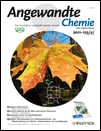Two- and Three-Dimensional Liquid-Crystal Phases from Axial Bundles of Rodlike Polyphiles: Segmented Cylinders, Crossed Columns, and Ribbons between Sheets†
This work was supported by the EC 7th and 6th Framework Programmes, under contracts 2007-2013 (NANOGOLD, grant agreement No. 228455), and ERAS-CT-2003-989409. It was also supported by the DFG and EPSRC as part of the ESF EUROCORES Programme SONS. G.U. acknowledges support from the WCU program through the National Research Foundation of Korea funded by the Ministry of Education, Science and Technology (R31-10013). M.P. acknowledges the support by the Cluster of Excellence “Nanostructured Materials” and DFG (FG 1145). For help with the synchrotron experiments we thank Drs. Nick Terrill, Jen Hiller (beamline I22), Steve Collins, and Alessandro Bombardi (beamline I16) at Diamond, and Drs. Simon Brown and Paul Thompson (BM28-XMaS) at ESRF.
Graphical Abstract
Stabförmige Mesogene (siehe Schema) mit Schwalbenschwanz-artigen Seitenketten ordnen sich axial zu bänderförmigen Bündeln an. Bei hoher Temperatur rotieren die Bänder unter Bildung einer neuartigen hexagonalen 3D-Flüssigkristallphase (siehe Bild, links). Bei niedrigerer Temperatur stoppt die Rotation, und man erhält eine Struktur aus gekreuzten aromatischen und fluorierten Säulen (rechts). Bei weiterer Abkühlung fusionieren die Bänder zu Flächen mit interkalierten fluorierten Säulen.





